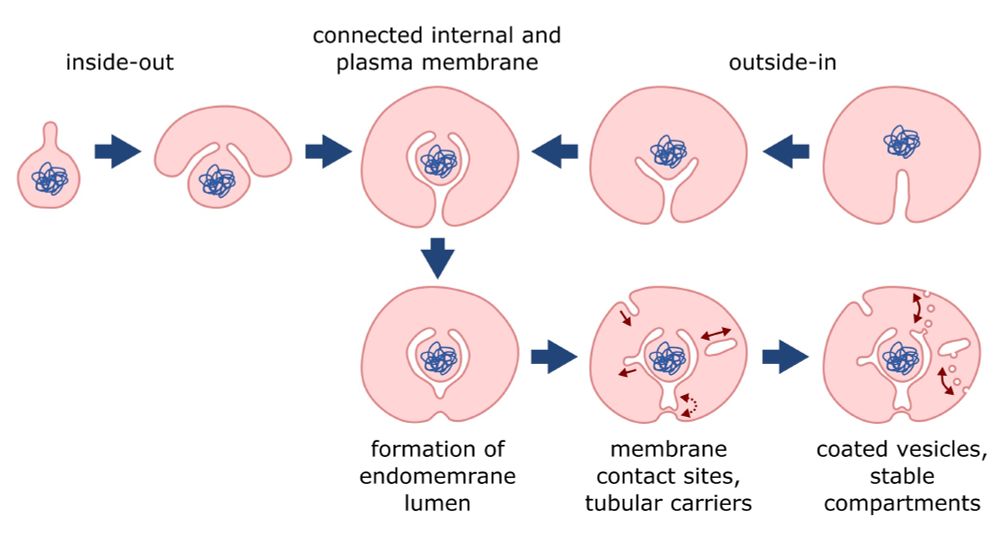Congratulations, Frank!
04.11.2025 11:54 — 👍 3 🔁 0 💬 1 📌 0

#MembraneTraffickers! Our next online seminar is this Thursday, Nov 6 at 5 PM CEST!
We’ll hear from @agatawitkowska.bsky.social on mechanical control of neurotransmission and @abdourachidthiam.bsky.social on lipid storage mechanisms in health and disease.
Spread the word and join the discussion!
03.11.2025 19:33 — 👍 21 🔁 15 💬 1 📌 0
Again, where exactly he used the term is a mystery for me now. While it can be attributed to my imagination, that is unlikely. I find it useful while discussing aspects of gene regulation.
05.08.2025 06:51 — 👍 0 🔁 0 💬 1 📌 0
However, Brenner highlighted that a major unsolved problem (“the left-hand side”) was how genes, through complex regulatory processes, give rise to the intricate architectures, behaviours, and functions in multicellular organisms.
05.08.2025 06:51 — 👍 0 🔁 0 💬 1 📌 0
This problem—how genetic information determines protein sequence—was solved mainly with the understanding of the genetic code and protein synthesis.
05.08.2025 06:51 — 👍 1 🔁 0 💬 1 📌 0
In his Nobel Lecture, Brenner explained that early molecular biology (“the right-hand side”) focused on how the linear sequence of DNA specifies the linear sequence of amino acids in proteins.
05.08.2025 06:51 — 👍 0 🔁 0 💬 1 📌 0
I read this—the“left-hand-side problem”—in a piece by Sydney Brenner. I can’t trace the piece or video now. I recollect that Brenner refers to the unresolved challenge of understanding how the cellular environment regulates genes to participate in creating the complex structures and functions.
05.08.2025 06:51 — 👍 1 🔁 1 💬 1 📌 0

A schematic showing two models for the evolution of the eukaryotic cell plan starting from an archaeal ancestor. The "inside-out" and "outside-in" models both lead to an intermediate stage with internal and plasma membranes connected by tubules. The sequence continues through the formation of an endomembrane lumen, followed by the emergence of membrane contact sites and tubular carriers, and finally coated vesicles and stable compartments.
I set out to review the evolution of eukaryotic intracellular traffic, but along the way a new hypothesis came into focus: maybe the earliest membrane carriers were tubules, not coated vesicles!
New preprint: ecoevorxiv.org/repository/v...
Here’s the idea. 🧵
04.08.2025 20:34 — 👍 41 🔁 15 💬 4 📌 1

A very Happy 2025 to all here and outside.
31.12.2024 18:05 — 👍 4 🔁 0 💬 0 📌 0
Biologist studying nervous system development and the development of behaviour.
Professor, Indian Institute of Science Education and Research (IISER), Pune
http://thelabofregeneration.in/Kalika_Prasad/index.html
maths, community & evolutionary ecology, evolution of cooperation. PhD-ing kokkonut in Mainz. amateur hiker and bread baker, professional stick insect parent. Previously: IISER Pune & the MPI for Evolutionary Biology
In search of a platform that widens and deepens our understanding of the world. Less re-posting, more reading. Listening more, talking less. My opinions are my own. Some of them aren’t even mine.
Institut Jacques Monod, Paris
@ijmonod.bsky.social
https://www.ijm.fr/raote-lab/
Collagen secretion, membrane trafficking
Formerly @crg.eu
Evolutionary cell biology @EMBL
evonuclab.org
Physicist fascinated by biology, trying to understand how cells work. Also: public engagement, science and culture, puzzles.
Cellular neurobiologist TIFR India who loves genetics, live imaging and worms. Science is fun, let's go exploring.
Sci comm, write bad poetry, 2 girl mom
lab: https://tinyurl.com/5n7s6ens
https://scholar.google.co.in/citations?user=c4zDSQ8AA
Biologist interested in Skin development & regeneration, ECM, Stem cell @RIKEN Kobe, Japan.
Neuroscience Professor at Harvard University. Personal account and posts here. Research group website: https://vnmurthylab.org.
Professor, Centre for Ecological Sciences, IISc.
Senior Politics Correspondent, Vox
Zoologist, orchard keeper, European. Want to understand how nervous systems develop and evolve. In favour of reading and reflection.
Bren Professor of Computational Biology @Caltech.edu. Blog at http://liorpachter.wordpress.com. Posts represent my views, not my employer's. #methodsmatter
Sabeti lab PostDoc @ Broad Institute of MIT an Harvard
genetics, compbio, & viruses
www.lauraluebbert.com
Theoretical Neuroscience, Deep Learning, & the space between.
Assistant Professor, Birla Institute of Technology & Science.
http://brain.bits-hyderabad.ac.in/venkat/
Evolutionary biologist into genomics of speciation, epigenetics, & reptiles. Here to share science & stories🦎🧬 🇮🇳🇩🇪🇬🇧🇨🇭
Postdoc at Uni Neuchâtel | Former Marie S. Curie postdoc @ the Natural History Museum London | National Geographic Explorer
Neuroscientist studying interactions between cognition, action & timing
Lab website: neuroact.in
Group Leader | NeuroACTLab @NCBS_Bangalore | SCAgingBrain fellow ➡️ faculty | Previously: @Neuro_CF @UCSF @UniofOxford @IiserMohali
Science, books, nature, climate change, scicomm, mental health.
https://thoughttrail.substack.com/
Comp neuro @fz-juelich.de. I develop NESTML, a DSL for neuron and synapse models. https://nestml.readthedocs.io
PhD student at IBDM and DyNaMO, Marseille


